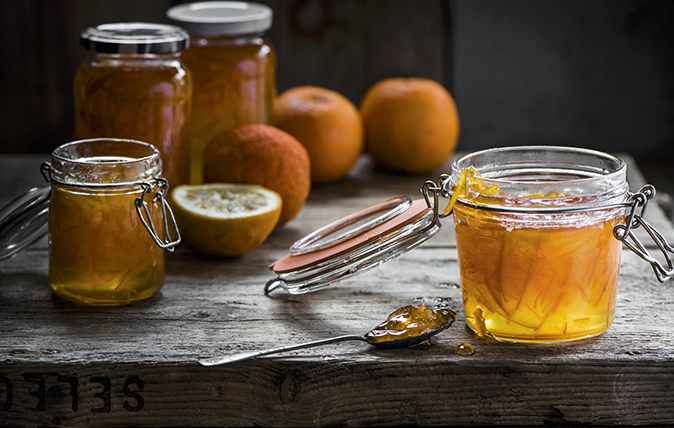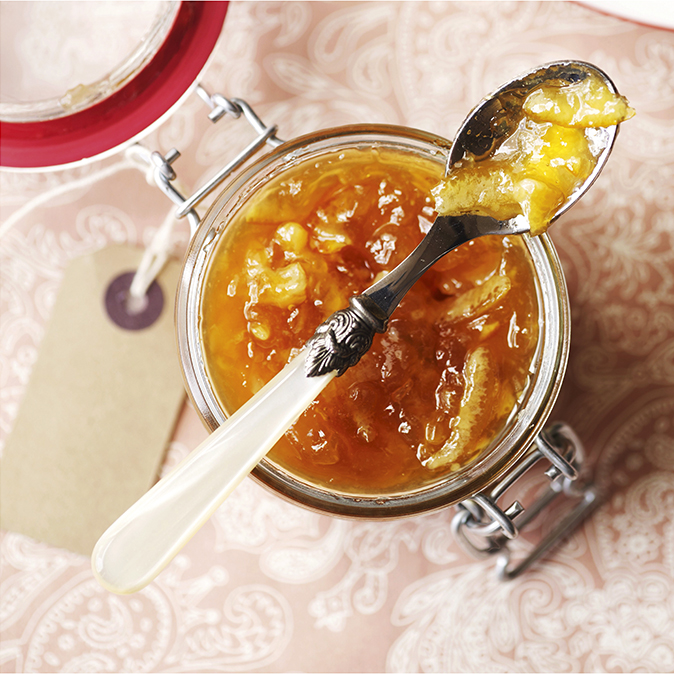The appeal of peel: How to make your own Seville orange marmalade
Marmalade should always have a special place in our hearts. And stomachs, of course.

For breakfast, this is both the best of times and the worst of times. On the one hand, the first meal of the day has never been so photographed, so elevated, so celebrated in newspapers and colour supplements. on the other, the dishes we’ve loved for decades could soon be wiped out entirely by chia-seed porridge and kale smoothies.
Of all the potential casualties in the war against stodge—sausage sarnies, porridge made with cream, fried bread—the saddest loss would surely be marmalade. Just think of the history: it was James Bond’s toast topping of choice (he always went for Cooper’s Vintage Oxford) and Sir Edmund Hillary took a jar up Everest. Not even Marmite can compete with that.
Made well, it’s also a thing of extraordinary complexity and beauty. A jar of really excellent marmalade looks like something precious that Indiana Jones would have held twinklingly up to the light.

However, we shouldn’t despair—not yet. For starters, marmalade’s patron saint, Paddington Bear, isn’t going down without a fight. ‘I’m not sure I like the sound of green juice very much,’ he told me over email, via his agent (always a dedicated letter-writer to his Aunt Lucy in Peru, he’s had to become au fait with electronic correspondence since the Paddington film came out in 2014). ‘I expect it would make my toast go soggy. Mr Gruber once told me that a famous person said a meal without wine is like a day without sunshine and I feel much the same way about marmalade. I can’t imagine what life would be like without it.’
If, like him, you’re keen to champion its cause, why not start by whipping up a batch of your own marmalade? Now’s the time. With the chaos of Christmas behind us and joyless January stretching ahead, dedicating a day to peeling and slicing things quietly in the kitchen is surely just what the doctor ordered.
Of course, you can make perfectly good marmalade from any citrus fruit, but, really, if you’re a first-timer, you want oranges. If you can source Sevilles, which are naturally high in pectin, so much the better (watch Waitrose like a hawk during their short season), but blood oranges are just as good. Look for firm fruits of a uniform size and make sure you freeze any you have left over.

Next, you need the right kit. A big, wide-bottomed pan is essential, but don’t fill it too enthusiastically—if it boils over, you’ll spend the rest of the month chipping sugar off your cooker. Try not to let the sugar catch, unless you’re aiming for a finished product that tastes of bonfires. (Speaking of taste, a good slug of booze never goes amiss. Whisky, Campari, even gin—if it goes well with orange juice in a cocktail, it’ll work in marmalade.)
Sign up for the Country Life Newsletter
Exquisite houses, the beauty of Nature, and how to get the most from your life, straight to your inbox.
For perfect results every time, there are a few simple rules you can follow. Make sure it’s set (once it’s been at a rolling boil for a quarter of an hour or so, use the ‘wrinkle test’, in which you spoon a little onto a cold saucer, leave it for a minute to cool, then prod it; if it’s ready to pot, it will wrinkle), but don’t be tempted to go past the setting point, unless you like tarmac on your toast.
Give it 15 minutes to stand once it’s ready—if you pour it out while it’s hot, all the peel will rise to the top of the jar. For a gorgeously clear amber result, skim any scum off the top of the marmalade before you pour it into jars.
So what are you waiting for? Dust off your jam pan, put the radio on and get preserving. It’s not merely a pleasure, but your duty. Just ask Paddington.
Make your own marmalade
Sarah Churchill, winner of last year’s World’s Original Marmalade Awards, shares her recipe for Seville-orange marmalade.
---- IMPORTANT NOTE: Due to an unfortunate error the recipe as printed in Country Life on 18 January specified 135g of sugar instead of 1,350g. The version below is correct and complete ----
Ingredients
- 675g fresh whole Seville oranges
- 1 large lemon
- 1.75 litres water
- 1,350g granulated white sugar
Equipment
- Large open pan with lid
- Sterilised clean glass jars and lids
- Large spoon
- A sharp heavy knife
- Muslin square and string
- Citrus juicer
- Jug
- Jam funnel
Method
- Cut the oranges and lemon in half and juice them. Pour the juice into the pan with the water and discard the lemon shell.
- Scrape out any remaining pips and membrane from the orange shells with a spoon or small, sharp knife. Spoon this mix into the muslin with any pips from the juicer and tie into a bag with string. Place the muslin bag in the liquid, hanging the string to the side of the pan.
- Cut the orange shells into quarters and, then, with the skin side up, slice the skin into the rinds. Choose your thickness of rind to your liking, from fine to chunky. Add these rinds, when chopped, to the liquid and soak overnight.
- The following day, bring the pan to the boil, then reduce to a simmer and cook gently for two hours with the lid on until the peel is very soft and tender. The liquid should have reduced by a third.
- Remove the muslin bag and squeeze out any liquid from it into the pan.
- Warm the sugar in a low oven, then add it to the liquid in the pan.
- Dissolve the sugar gently and bring the pan up to a rapid boil. Start to test for a set after five minutes. You can do this by taking a spoonful of marmalade and turning it horizontally. If some marmalade hangs from the side of the spoon, the setting point has been reached.
- When the marmalade has reached setting point, turn the heat off. Let it stand for a couple of minutes and remove any scum from the surface with a spoon. Stir the marmalade and pour it into your sterilised jars with a jug and funnel. Screw the the lids on immediately.
- Leave to set for 24 hours, then enjoy!
-
 Two quick and easy seasonal asparagus recipes to try this Easter Weekend
Two quick and easy seasonal asparagus recipes to try this Easter WeekendAsparagus has royal roots — it was once a favourite of Madame de Pompadour.
By Melanie Johnson
-
 Sip tea and laugh at your neighbours in this seaside Norfolk home with a watchtower
Sip tea and laugh at your neighbours in this seaside Norfolk home with a watchtowerOn Cliff Hill in Gorleston, one home is taller than all the others. It could be yours.
By James Fisher